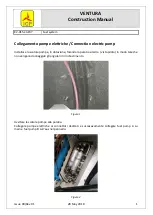
SECTION 3 / USAGE
Wing Assembly (Rigging)
The wing assembly is the start of a thorough PREFLIGHT. The assembly operation must be
carried out unhurriedly, without using force and methodically:
•
position the wing nose into wind, open the cover
•
Turn the wing over, Control frames on the ground (on canvas, grass, a smooth surface)
•
remove the cover
•
fit the king-post to the keel, between the cross spar tensioning cables (2)
•
hang the upper-longitudinal rear cable near the king-post, without crossing the cables
Note: the part small diameter of the hook will be directed upwards (3)
•
position the nose batten on the head of the CHC 6 front screw
•
pull the leading edges outwards, grasping them in the middle, without raising or forcing
them (1)
•
pull the control frame outwards, checking that no cable passes inside the frame
•
fit the control bar using the M8 bolt (wing nut + safety ring)
Note: preferably position the wing nut towards the nose of the wing so as not to tear the front
seat cover when the control bar rests against it
•
slide upper wing surface battens into their respective sleeves
Note: the leading edge batten ends are ‘colour-coded’, red for the port (left) side and black,
green or white, for the starboard (right) side
•
check the position of the side and longitudinal cables
•
pull on the cross spars tensioning cables
Note: to facilitate this operation, raise the tip of one of the leading edges to knee height (i.e.
give the wing a little dihedral)
•
lock the tension lever (or goose neck) using the pit-pin (2).
Note: the end of the tension lever is divided, lock it immediately. On the level of the king post,
the left tensioning cable of must be higher than that located on the right.
•
tighten the upper surface battens, pass the shock-cord in double (4, 5).
•
raise the wing by the back of the keel, by making it swivel on its bar of control
•
tension the front cables and lock the tension lever using the pit-pin.
•
place the nose of the gently on the ground, nose into wind
•
slip the under-surface battens into their respective sleeves (6, 8).
Note: the batten tip is spoon shaped, with the hollow side, cupped towards the leading edge
(7). Red tip to the left; black, white or green, to the right
•
insert the washout tubes (dive sticks) in the leading edge
•
close the wing ends
•
attach the nose cap.
Note: the absence of the nose cap creates an internal pressure variation in the wing which
causes fundamental changes in the wing profile and makes the wing heavier to control.
Note: in moderate or strong winds secure the wing by its nose.
Attaching the wing to the Airframe
See the Airframe Instruction manual.
Wing Disassembly (De-rigging)
Follow the Wing Assembly procedure, except in reverse. Before placing the wing on the ground,
the hang bracket protection on the top of the control frame must be fitted to the keel and the under-
surface battens and the hang block remove (10). Before folding up both sides of the wing, to
withdraw the washout tubes from their sockets and fold back them along the leading edge.
MAUT DYN 450
Edition : June 2005
Section : 3 - 01







































